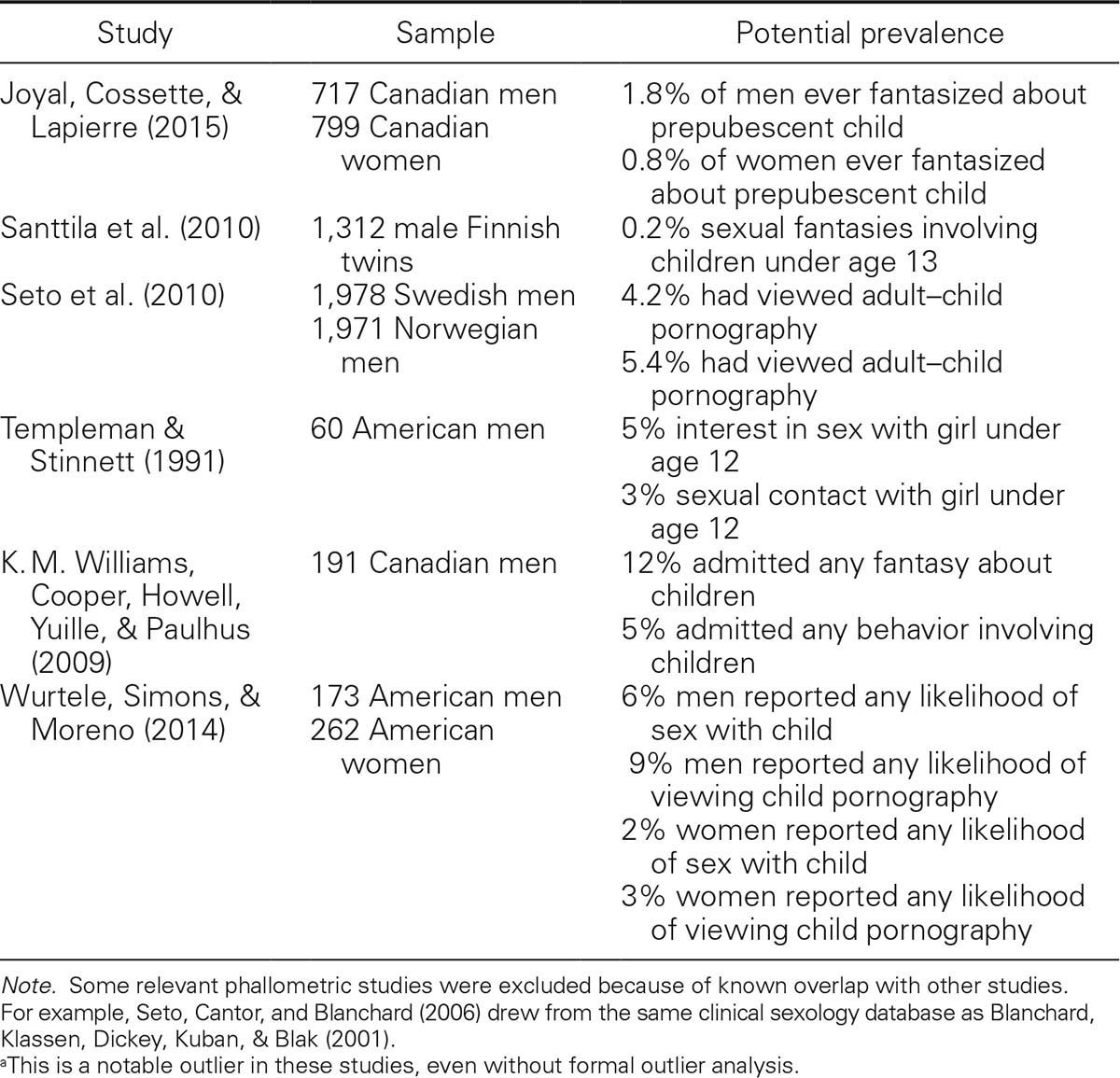TABLE 1.3
Upper-Limit Prevalence Estimates of Pedohebephilia (Continued
)
Two surveys are of particular interest because they are population representative: Santtila et al.’s (2015) study of 1,310 Finnish twins found that 0.2% of the sample reported sexual interest in children age 12 or younger; the concomitant value when including pubescent child age ranges, that is, children age 15 or younger, was 3.3%. A limitation in this survey was that the age ranges used did not fully map onto pedophilia and hebephilia. The second population-representative survey, conducted in Sweden and Norway, found that 4% of young men reported viewing pornography depicting adult–child sex (Seto et al., 2010). As noted, the actual prevalence rate must be lower because they did not have data on how often the men viewed child pornography, how it was initiated, and what their reactions were (e.g., sexual arousal vs. revulsion).
I specifically mention Crépault and Couture (1980) because it is an obvious outlier compared with the other surveys shown in
Table 1.3
. Crépault and Couture surveyed 94 men about their specific sexual fantasies during masturbation or intercourse, and found that 62% had fantasized about having sex with a young girl and 3% had fantasized about having sex with a young boy. No other study gets a value even close to 62%, and indeed most studies find a prevalence rate that is a lower order of magnitude.
The other studies to mention are those of female respondents. Fromuth and Conn (1997) asked 546 college women about their sexual experiences with children at least 5 years younger than them. Four percent of the sample acknowledged at least one such experience (most experiences involved kissing or touching). The average age of the older person was 12, and the average age of child was 6. Thirteen percent of the respondents said they did not initiate the experience. The majority of children identified in this anonymous survey were boys (70%), and the majority of children were related (69%) to the women. None of the incidents were detected by police or child protection authorities.
Joyal, Cossette, and Lapierre (2015) asked both men and women about a range of different paraphilic interests, including whether the respondent had fantasized about sex with a child under the age of 12: Women were half as likely (0.8% vs. 1.8%) as men to endorse this fantasy. However, this single item does not capture intensity, frequency, or valence. Having a single sexual fantasy would qualify, even if it was not intense or was upsetting to the respondent. Nonetheless, Joyal et al. showed that women are less likely than men to report paraphilic interests or behavior, which suggests that men show more sexual variation, are more antisocial (willing to engage in paraphilic behavior and willing to admit it) and might also be further evidence of “selective male afflictions” (see
Chapter 5
). The largest sex differences were for paraphilias that involve acting against the consent of others (exhibitionism, voyeurism, biastophilia) and the smallest gender difference was for masochism.
ARE PEDOPHILIA AND HEBEPHILIA UNIVERSAL CONCEPTS?
It is easy to assume that pedophilia, hebephilia, and sexual offending against children are universal, found both historically and cross-culturally, but what is the evidence? This is particularly challenging for pedophilia and hebephilia because their definitions require information about sexual thoughts, fantasies, and sexual arousal, all of which would be difficult to find in historical or anthropological records. Instead, researchers must rely on evidence of adult–child sex because it is relevant pedosexual or hebesexual behavior.
2
Indeed, even with contemporary evidence, most of what is known about pedophilia and hebephilia comes from the study of men who have had sexual contact with prepubescent or pubescent children, especially those seen in criminal justice settings (police arrests, courts, jails or prisons, probation or parole). Much of this book therefore still depends on identified sex offenders against children: the proportion of these offenders who are likely to have pedophilia varies across settings, the types of offenses, and measures used. Across studies, the average prevalence of pedophilia is approximately 50% but varies depending on pedophilia indicator, setting, and sample characteristics (see
Table 1.4
). This prevalence may include hebephilic offenders because of the high overlap between indicators of pedophilia and hebephilia (Stephens, Seto, et al., 2017b). The prevalence is higher among child pornography offenders; for example, Seto, Cantor, and Blanchard (2006) found that two thirds of child pornography offenders showed greater sexual arousal to children than to adults, compared with half of the contact sex offenders. The explanation we offered is that child pornography offenders seek out content that corresponds to their sexual interests, given the much greater availability of mainstream adult content. In contrast, some contact offenders act upon pedophilic motivations whereas others are more opportunistic (see the motivation–facilitation model in
Chapter 4
, this volume). This distinction between pedophilia or hebephilia (interest) and sexual offending against children (behavior) needs to be kept in mind when reading this book or the corresponding literatures.

